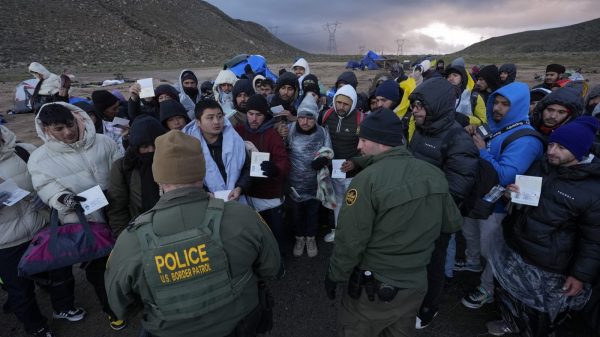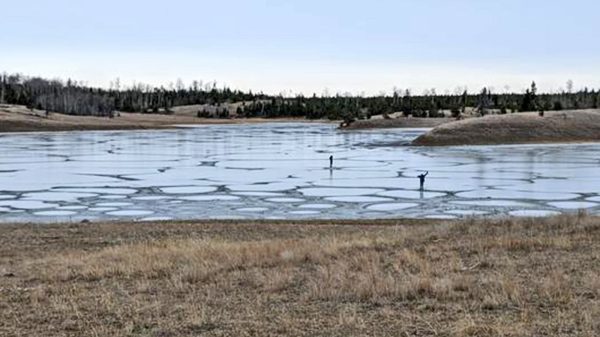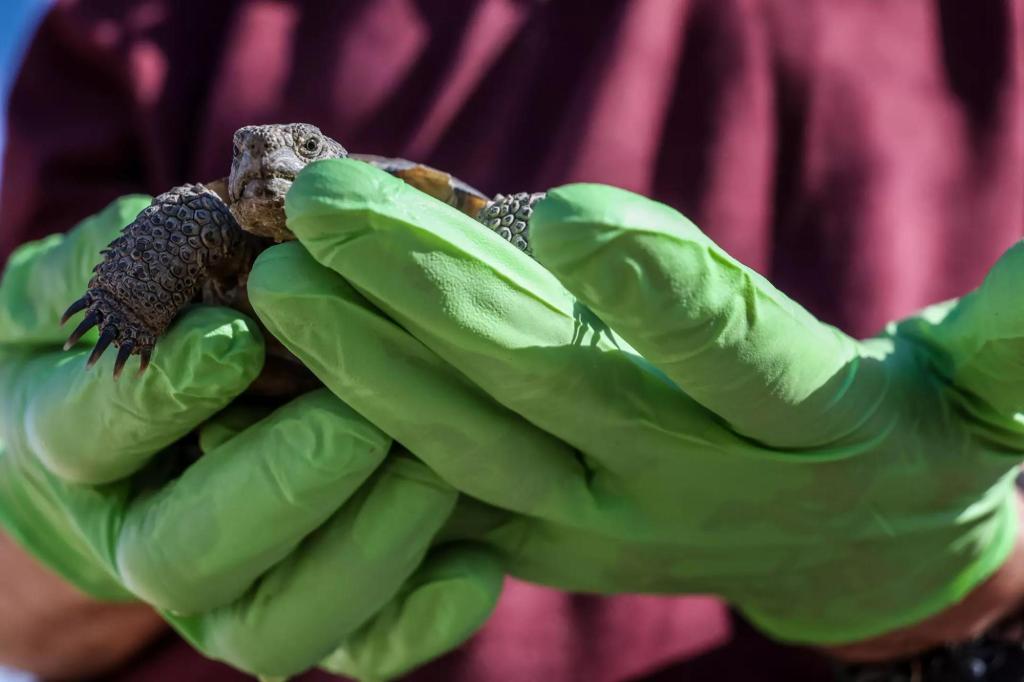
By Alex Wigglesworth, Los Angeles Times (TNS)
Reporting from TWENTYNINE PALMS Marine Corps base, Calif. — The two tiny tortoises emerged from their burrows as soon as they detected Brian Henen’s footsteps, eager for the handfuls of bok choy and snap peas that would soon be tossed their way.
It will be a few years before the tortoises, roughly the size of playing cards, have shells tough enough to avoid becoming prey for the ravens soaring above. So for now, they live with roughly 1,000 others of their species in a sheltered habitat ringed by barbed wire and draped in netting.
The elaborate setup on the Marine Corps Air Ground Combat Center is designed to protect the tortoises not only from ravens, coyotes and other predators, but from rumbling tanks, live explosives and anything else that might put them in harm’s way at the 1,189-square-mile Mojave Desert base.
“The desert tortoise is considered a keystone species, which means that they have a disproportionate effect on the entire ecosystem,” says Henen, a civilian who heads the conservation branch of the base’s Environmental Affairs Division.
The tortoises pockmark the desert floor with burrows that other animals use for shelter, and disperse the seeds of native plants in their waste. “They’re influencing what else can exist on the landscape,” Henen said.
With its barbed-wire enclosure, some call this place Tortoise Gitmo, after the U.S. Navy’s Guantanamo Bay base and prison camp in Cuba. Others call it the Tortoise Bordello, although the young tortoises are released before they are mature enough to breed.
Officially it’s called the Tortoise Research and Captive Rearing Site, and since it was established in 2005 it has helped scientists learn how to protect a species that’s threatened by human encroachment, disease and climate change.
In the first iteration of the program, biologists gathered eggs from wild females and raised the hatchlings until they were hardy enough to stand a chance against predators and drought, in a process known as head-starting.
The facility got an influx of new tenants in 2017, when the military relocated tortoises to make way for a controversial expansion of the base’s training grounds. Biologists decided to head-start about 550 young tortoises that were taken from expansion areas.
Then, starting a couple of years ago, Henen’s team began gathering, incubating and hatching eggs from the relocated adult tortoises to study whether they were breeding with their new neighbors. Rather than release the hatchlings into the wild, where they were unlikely to survive, they decided to head-start them as well.
Some desert conservationists are critical of the efforts, saying the captive rearing program is essentially a smokescreen that distracts from the pressing need to conserve critical habitat.
“What I’d like to see is this kind of effort being done on public lands as a tool to repatriate areas as opposed to minimizing the impacts of the Marine Corps expansion,” said Ed LaRue, a board member of the nonprofit Desert Tortoise Council.
“Hundreds of square miles of good tortoise habitat is now being used for military maneuvers,” LaRue said, citing base expansions at Twentynine Palms and at Fort Irwin National Training Center near Barstow. “It enables the military to go ahead and degrade the desert and claim it’s successful because the tortoises have been moved out of the way.”
Bases should instead stop expanding into tortoise habitat, he said.
Henen says the program has enabled biologists to both augment tortoise populations and track the success of those efforts by committing to decades of monitoring.
He also points out that the Marine Corps Air Ground Combat Center has partnered with a coalition of agencies and nongovernmental organizations to conserve land off base. And inside the boundaries of the massive installation, officials have identified the most valuable tortoise habitat and set aside 43,800 acres of restricted areas that protect the species, as well as other natural and cultural resources, he says.
Marines at Twentynine Palms receive specialized training on how to handle tortoises. A glimpse of a single reptile interloper will bring a training exercise to a halt. Troops must radio in to range control and request permission to move the animal. If permission is granted but the tortoise urinates, which can cause them to become dangerously dehydrated, the soldiers must call it in again and wait for a base ecologist to respond.
Desert tortoises were once so plentiful that people driving through the Mojave would take them home to keep as backyard pets. But in some patches of California desert, their numbers have dropped by up to 96% since the 1970s, according to study plots monitored by Kristin Berry, supervisory research wildlife biologist at the U.S. Geological Survey’s Western Ecological Research Center.
Recognizing the dire straits, the California Fish and Game Commission in April voted to uplist desert tortoises from threatened to endangered.
The Marines are hardly the only threat to tortoises. Roads and highways have carved up previously wide-open stretches of desert into parcels that are in some cases too small to allow for the breeding and genetic diversity needed to sustain their population health. A warming climate has dried up the precipitation needed to sustain them in some places.
Livestock not native to the desert have grazed and trampled the plants tortoises like to eat, spreading unpalatable nonnative grasses in their wake. Power lines have added miles of resting perches for ravens, allowing them to more easily spot young tortoises.
Ravens used to be rare in the desert — they could only subsist for a couple of months in the springtime of good rainfall years, said Ken Nagy, professor emeritus at UCLA, who with Henen founded the program at Twentynine Palms. But now, thanks to everything from leaky faucets at gas stations to the irrigation of alfalfa fields, the birds have year-round sources of drinking water that’s caused their population to explode to 30 to 50 times greater than what it once was, he said.
“You can go beneath raven nests on power poles and see piles of dead baby tortoises that were opened, killed, carried to the nests by adults and fed to the babies,” he said. “That is what started this whole thing.”
In desert tortoise head-starting programs, biologists use radio transmitters to monitor wild females and portable X-ray machines to determine when they’re pregnant. They bring those females inside enclosures to lay their eggs, then release them. The hatchlings are reared in captivity until they reach a certain length — Twentynine Palms uses a threshold of 110 millimeters, or about 4 inches long, which can take between seven and nine years — and then rereleased, typically with radio transmitters to monitor their health and movements.
The concept was pioneered in the 1990s at Fort Irwin, followed by a similar program at Edwards Air Force Base near Mojave.
The captive rearing site is tucked in an isolated corner of the base, down a sandy road flanked by mesquite dunes and wrinkled mountains; past collections of buildings used for training that resemble crudely built neighborhoods. Fences to keep Marines on the road have spiky pins atop each post to prevent ravens from having yet another place to perch.
Inside the facility, a clanging noise echoes through the pens. It’s a particularly exuberant tortoise nicknamed Typhoid Mary, who got the nickname because she harbors a contagious bacteria that causes upper respiratory tract disease.
She has heard the biologists coming and wants a snack. She bangs her shell against the metal divider to get their attention. Henen hands her some kale, which stains her beak green.
Mary is believed to be at least 30 years old. One of the few adults at the facility, she ended up here as a result of the 2017 base expansion during which the military used helicopters to relocate more than 1,000 tortoises to other areas, most of them off base. Scientists are currently monitoring about 125 of those adults and 50 juveniles via radiotelemetry so they can keep tabs on their health and movements.
But Mary was placed on the no-fly list after she was found to harbor mycoplasma bacteria. Upper respiratory tract disease has also contributed to tortoise declines, usually in populations that are close to human communities. Scientists believe it may be spread by people releasing sick pet tortoises into the wild, Henen said.
Despite the disease, Mary has remained in relatively good health because she’s well-fed and hydrated. Still, she’ll probably be living out her days here to avoid infecting others.
The program, and others like it, have won converts over the years.
Biologist Tim Shields, who founded a company that develops tortoise conservation technology, was once opposed to head-starting because he thought it was unnatural and the tortoises would be inferior at survival.
“But some very intelligent people have spent a lot of time figuring out a formula for essentially mass production of tortoises — and I’m all for it,” he said. “Because the underlying ecosystem is so bunged up that I don’t see an alternative.”
©2024 Los Angeles Times. Visit at latimes.com. Distributed by Tribune Content Agency, LLC.













































